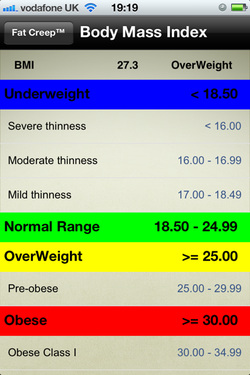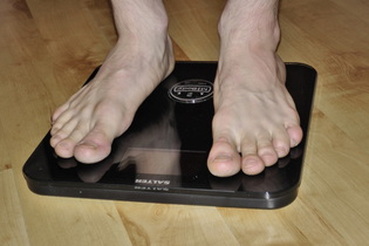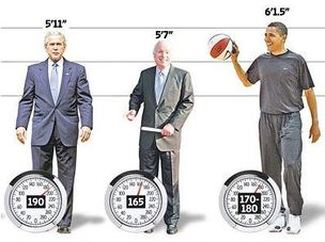|
By Dr Harry Most of us have heard of the body mass index (BMI): your doctor uses it to classify how fat or thin you are; it’s the measure that magazines and newspapers use to inform us of the “obesity problem” in the developed world and insurance companies sometimes use it to determine your health insurance premium. But what exactly is it? BMI is simply a number which relates your weight to your height. Despite the metric’s flaws, its simplicity has led to its wide use and as such it is likely to affect your life whether you like it or not! Not least because a high BMI could lead to more expensive health insurance. How to calculate the BMI To find out what your own BMI is, all you need is your current weight and height and the mathematical formula below.
Examples: 1. Weight = 66kg, Height = 1.55 meters. BMI = 66 ÷ (1.55 x 1.55) = 27.5 2. Weight = 135 lbs, Height = 66 inches. BMI = (135 x 703) ÷ (66 x 66) = 21.8 3. Weight = 135 lbs, Height = 5 feet 6 inches. BMI = (135 x 4.88) ÷ (5.5 x 5.5) = 21.8 Note: 66 inches is the same thing as 5 feet 6 inches. The Fat Creep™ iOS and android app calculates BMI for you if you enter your height on settings page 2. Some people don't believe the BMI metric suits their body type so the functionality has been included in a non-intrusive way. What does the body mass index (BMI) number mean? Based on WHO criteria Based on WHO criteria You probably know already, because it is so popular in the media, that having a high BMI can be bad because it means you are overweight or obese. But if we start by looking at the other end of the scale, a low BMI value is just as unhealthy. You can see a table showing the range of BMI values in the Fat Creep™ app - press the BMI button on the home page. If you have a BMI less than 17.50 you are officially malnourished and could be anorexic. This is a medical condition and a serious emergency. You are so thin that you are endangering your health and need urgent medical attention. If your BMI is between 17.50 and 18.50 you are still underweight. Between 18.5 and 24.99 you are classified as having a “normal” BMI. The World Health Organization sets the minimum threshold for normality at 18.50 and that is why we have used it here but many other health organizations and professionals identify 20 - 24.99 as normal. And any BMI below 20 is considered underweight. A BMI between 25 and 30 is “overweight”. If your BMI is above 30 you are officially obese. This is another medical condition and you are putting yourself at risk. You should see a doctor about strategies to lose weight and reduce your BMI to the healthy range. After a BMI value of 30, the higher your BMI gets the more at risk you are putting yourself.
Some people ask me whether the BMI has its flaws and whether it is the correct measurement for them. I will be answering that question, and looking into where BMI all began in my next blog post. If you have any comments or want to share your experiences with me, please do get in touch.·  Although your personal finances and your business success are my primary interest, I believe you only operate at peak efficiency when you're fit and healthy. If you feel good, it filters through to your work. To help you with that, click for your free ebook: The Quick Guide to Sexy
0 Comments
Leave a Reply. |
By Heather
|
Heather Katsonga-Woodward, a massive personal finance fanatic.
** All views expressed are my own and not those of any employer, past or present. ** Please get professional advice before re-arranging your personal finances.



 RSS Feed
RSS Feed


